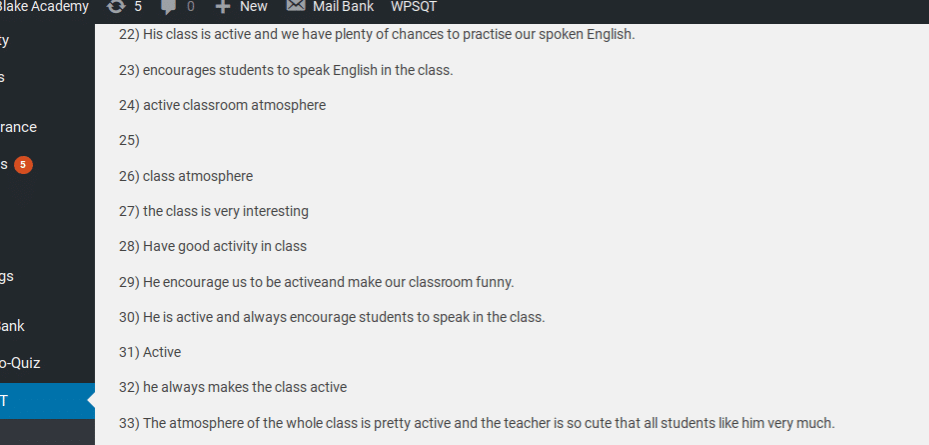The importance of authentic English materials in China.
Due to the academic system of memorization and learning obscure words, Chinese students often struggle to use oral English because they don’t know how to use vocabulary in a real-world application.
The criticism of CET4 and CET6, China’s standardized English exams, includes that the oral English portion of the tests is not compulsory. In real-world situations, you are required to speak a second language much more than ever having to write it academically. A student who decides to live overseas may be completely lost in simply ordering a sandwich because they spent their preparatory days writing down academic words never to be used in actual communication.
As highlighted in a CET analysis, researchers challenge the CET by pointing out that the test does not assess communicative competence as the teaching syllabus requires.[1]
There is no doubt that the CET test is a fair evaluator of general English skills, but test-taking itself is not an evaluator of oral communication skills. The goals of a foreign teacher’s oral English class are often focused on everyday communication and presentation skills. It is oral communication skills that will get the student to pass future job interviews or higher-education entrance interviews. A student with decent reading and writing skills may have great test scores but often does not have the confidence to communicate with foreigners at the most basic level. Listening to an unnatural, slow recording repeatedly may improve listening skills somewhat, but this is no replacement for real-life interaction with a foreign teacher. A good ESL teacher gives confidence in speaking to English language learners. Failing, demeaning, or embarrassing a student who shows great effort does not set the stage for success in language learning.
Students know best
In September of 2015, I started giving my students surveys about 4 weeks into the term for direct, student-focused feedback. This allows for each student to express their expectations, likes, dislikes, and suggestions for the course. It gives them ownership over their learning and provides amazing results for in-class participation and involvement. I read each student’s comments and apply all of them in the classroom. In academia, this is called a feedback loop. I usually run far away from schools that use student feedback as some way to punish teachers or to assert authority. Feedback is an important tool in a teacher’s academic toolbox.

Students often ask for authentic English materials because the culture interests them, but it is my job to turn that three-minute clip into an academic lesson of value. This takes hours of lesson planning and looks effortless when executed properly. Typically it involves teaching sentence structures, vocab and expressions prior, giving critical thinking or research tasks that challenge their English skills, and dictating comprehension questions. On occasion it involves stopping a clip 30-seconds in, requiring each team to say what will happen next, retell the story or present their ideas. It involves matching topics to the existing curriculum and improving upon it. Often, it is applying a concept in the book and bringing it into the real world of English communication.
The frustration of practical, educational lessons
I am often following a 10 to 20 step lesson plan, step-by-step and a few students may not even realize the amount of speaking and creating their group did. What did you do in class today? “Oh, we just watched a three-minute film.” What did you do the other hour and a half???
When a class is active, language learners may not even realize their output, the number of corrections, its relation to the curriculum, or the everyday expressions they used and learned. They’ll make presentations nearly every class, solve problems, learn to work together and it will somehow be given less value because it wasn’t a one-time speech for the entire term that they spent all night memorizing, never to use again.
Many academic studies show that most students learn from each other.[2] This is precisely why I design my classroom in desk clusters or small groups. In a language learning environment, it is important to focus on student output and this design optimizes my correction through movement around the classroom. In addition, the students are constantly correcting each other in a comfortable environment that eliminates making a mistake in front of a whole class. Mistakes are the only way to improve in language learning and the learning environment must be a comfortable, safe space to maximize student output.
Students learn the most by becoming the teacher.[3] An additional advantage of this classroom setup is the ability to assign group tasks to every class, in which each group must present their solutions in English only to the class. This may be retelling a story, predicting what happens next, summarizing, or analyzing a brief text or authentic English clip.
Authentic materials have at least three layers of learning embedded within them: language, cultural insights, and practical application (Spelleri, 2002).[4] These layers motivate the students intrinsically because students have the chance to enjoy both learning the language and the culture.
[1] Zheng, Ying & Cheng, Liying. (2008). College English test (CET) in China. Language Testing. 25. 408-417.
[2] Boud, D. (2001). ‘Introduction: Making the Move to Peer Learning’. In Boud, D., Cohen, Ruth & Sampson, Jane (Ed.). Peer Learning in Higher Education: Learning From & With Each Other. London: Kogan Page Ltd, 1–17.
[3] Researchers J. F. Nestojko and D.C. Bui of Washington University, E.L. Bjork of the University of California and Nate Kornell of Williams College
[4] Spelleri, M., 2002. From lessons to life: Authentic materials bridge the gap. ESL Magazine.

